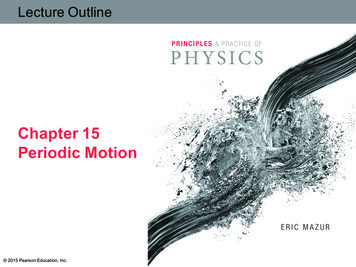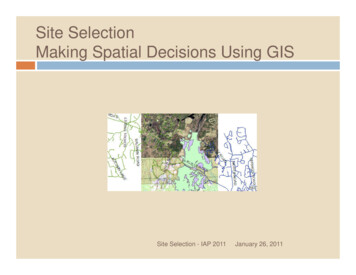
Transcription
letters to natureadvance online publication.Detecting recent positive selectionin the human genome fromhaplotype structurePardis C. Sabeti*†#, David E. Reich*, John M. Higgins*,Haninah Z. P. Levine*, Daniel J. Richter*, Stephen F. Schaffner*,Stacey B. Gabriel*, Jill V. Platko*, Nick J. Patterson*, Gavin J. McDonald*,Hans C. Ackerman‡, Sarah J. Campbell‡, David Altshuler*§,Richard Cooperk, Dominic Kwiatkowski‡, Ryk Ward† & Eric S. Lander*{* Whitehead Institute/MIT Center for Genome Research, Nine Cambridge Center,Cambridge, Massachusetts 02142, USA† Institute of Biological Anthropology, University of Oxford, Oxford, OX2 6QS,UK‡ Wellcome Trust Centre for Human Genetics, Roosevelt Drive, Oxford, OX3 7BN,UK§ Departments of Genetics and Medicine, Harvard Medical School, Department ofMolecular Biology and Diabetes Unit, Massachusetts General Hospital, Boston,Massachusetts 02114, USAk Department of Preventive Medicine and Epidemiology, Loyola UniversityMedical School, Maywood, Illinois 60143, USA{ Department of Biology, MIT, Cambridge, Massachusetts 02139, USA# Harvard Medical School, Boston, Massachusetts 02115, USA.natureThe ability to detect recent natural selection in the humanpopulation would have profound implications for the study ofhuman history and for medicine. Here, we introduce a framework for detecting the genetic imprint of recent positive selectionby analysing long-range haplotypes in human populations. Wefirst identify haplotypes at a locus of interest (core haplotypes).We then assess the age of each core haplotype by the decay of itsassociation to alleles at various distances from the locus, asmeasured by extended haplotype homozygosity (EHH). Corehaplotypes that have unusually high EHH and a high populationfrequency indicate the presence of a mutation that rose toprominence in the human gene pool faster than expected underneutral evolution. We applied this approach to investigate selection at two genes carrying common variants implicated inresistance to malaria: G6PD1 and CD40 ligand2. At both loci,the core haplotypes carrying the proposed protective mutationstand out and show significant evidence of selection. Moregenerally, the method could be used to scan the entire genomefor evidence of recent positive selection.The recent history of the human population is characterized bygreat environmental change and emergent selective agents3. Thedomestication of plants and animals at the start of the Neolithic,roughly 10,000 years ago, yielded an increase in human populationdensity. Humans were confronted with the spread of new infectiousdiseases, new food sources and new cultural environments. The last10,000 years have thus been some of the most interesting times inhuman biological history, and may be when many importantgenetic adaptations and disease resistances arose.We sought to design a powerful approach for detecting recentselection. Our method relies on the relationship between an allele’sfrequency and the extent of linkage disequilibrium (LD) surrounding it. (LD often refers to association between two alleles. Here, weuse it to measure the association between a single allele at one locuswith multiple loci at various distances.) Under neutral evolution,new variants require a long time to reach high frequency in theThis advance online publication (AOP) Nature paper should be cited as“Author(s) Nature advance online publication, 9 October 2002(doi:10.1038/nature01140)”. Once the print version (identical to the AOP)is published, the citation becomes “Author(s) Nature volume, page (year);advance online publication, 9 October 2002 (doi:10.1038/nature01140)”.population, and LD around the variants will decay substantiallyduring this period owing to recombination4,5. As a result, commonalleles will typically be old and will have only short-range LD. Rarealleles may be either young or old and thus may have long- or shortrange LD. The key characteristic of positive selection, however, isthat it causes an unusually rapid rise in allele frequency, occurringover a short enough time that recombination does not substantiallybreak down the haplotype on which the selected mutation occurs. Asignature of positive natural selection is thus an allele havingunusually long-range LD given its population frequency. Thedecay of LD, and therefore the relative scale of ‘short’- and ‘long’range LD, is dependent on local recombination rates. A general testfor selection on the basis of these principles must therefore controlfor local variation in recombination rates.We developed an experimental design to detect positive selectionat a locus using the breakdown of LD as a clock for estimating theages of alleles. We began by genotyping a collection of singlenucleotide polymorphisms (SNPs) in a small ‘core region’ toidentify the ‘core haplotypes’. We selected SNPs of sufficient density,so that recombination between them would be extremely rare andthe core haplotypes could be explained in terms of a single genegenealogy (Supplementary Fig. 1). Zones of very low historicalrecombination were identified by looking for clusters of SNPs whereHudson’s R M was 0 and jD 0 j was one6,7 (see Supplementary Fig. 1).We then added increasingly distant SNPs to study the decay of LDfrom each core haplotype. To visualize this process, we generatedhaplotype bifurcation diagrams that branch to reflect the creation ofnew, extended haplotypes by historical recombination proximal anddistal to the core region. We measured LD at a distance x from thecore region by calculating the extended haplotype homozygosity(EHH). EHH is defined as the probability that two randomly chosenchromosomes carrying the core haplotype of interest are identicalby descent (as assayed by homozygosity at all SNPs8) for the entireinterval from the core region to the point x. EHH thus detects thetransmission of an extended haplotype without recombination. Ourtest for positive selection involves finding a core haplotype with acombination of high frequency and high EHH, as compared withother core haplotypes at the locus. An attractive aspect of thisapproach is that the various core haplotypes at a locus serve asinternal controls for one another, adjusting for any unevenness inthe local recombination rate.We applied our approach to two genes that have been implicatedin resistance to the malaria parasite Plasmodium falciparum. Glucose-6-phosphate dehydrogenase (G6PD) is a classical example of agene where variants can confer malaria resistance9. Evidence overthe past 40 years has shown that the common variant G6PD-202Aconfers partial protection against malaria, with a case-control studyestimating a reduction in disease risk of about 50% (ref. 1). TheCD40 ligand gene (TNFSF5) encodes a protein with a critical role inimmune response to infectious agents. One case-control studyFigure 1 Experimental design of core and long-range SNPs for G6PD and TNFSF5. Thecore region is highlighted by a cluster of densely spaced SNPs (arrows) at the gene.Additional, widely separated flanking SNPs, used to examine the decay of LD from eachcore haplotype, are also shown. Markers distal to G6PD were within repetitivesubtelomeric sequence and could not be genotyped. 2002 Nature Publishing GroupNATURE 9 OCTOBER 2002 doi:10.1038/nature01140 www.nature.com/nature1
letters to natureadvance online publicationsuggested that a common variant in the promoter region, TNFSF5726C, is associated with a similar degree of protection againstmalaria2.We first studied G6PD (Fig. 1). We defined a core region of15 kilobases (kb) at G6PD and genotyped 11 SNPs in 3 African and 2non-African populations. The SNPs defined 9 core haplotypes(Table 1a) (denoted G6PD-CH1 to 9, for core haplotypes 1 to 9).The G6PD-202A allele, which has been associated with protectionfrom malaria, was carried on only one core haplotype, G6PD-CH8.Notably, G6PD-CH8 is common in Africa (18%), where malaria isendemic, but is absent outside of Africa. For carrying out our testfor selection, we focused on the three African populations, whichdid not differ significantly with respect to core haplotype frequencies (by Fisher’s exact test10) and hence were pooled for the mainanalysis. (Analyses were also performed separately for each population, yielding qualitatively similar results; see below.)G6PD-CH8 demonstrates clear long-range LD (as seen by thepredominance of one thick branch in the haplotype bifurcationdiagram (Fig. 2a)) and has correspondingly high EHH. The EHH is0.38 at the largest distance tested; that is, 413 kb (Fig. 2c). For eachcore haplotype we calculated the relative EHH; specifically, thefactor by which EHH decays on the tested core haplotype comparedwith the decay of EHH on all other core haplotypes combined(Methods).To test formally for selection, for each core haplotype, wecompared the allele frequency to the relative EHH at variousdistances (Fig. 2e shows the comparison at 413 kb proximal toG6PD). G6PD-CH8 has a much higher relative EHH than otherhaplotypes of comparable frequency, but is this statistically significant? To obtain a sense of how unusual our observation is, wesimulated haplotypes using a coalescent process (see Methods andFig. 2e)11. The deviation from the simulation results is highlysignificant and becomes progressively more marked with increasingdistance (Fig. 2g) (P-values at 413 kb proximal are: constant-sizedpopulation, P , 0.0008; expansion, P , 0.0006; bottleneck,P , 0.0008; population structure, P , 0.0008; see Methods andSupplementary Table 2 for details of the demographic models weconsidered). The frequency and LD properties of G6PD-CH8 areincompatible with what is expected under a model of neutralevolution for a wide range of demographies. Furthermore, whenthe three African populations comprising the pooled sample wereconsidered separately, a signal of selection was identified independently in each population (Yoruba, P , 0.0012; Beni, P , 0.0440;and Shona, P , 0.0030, based on simulation of a constant-sizedpopulation), demonstrating that the signal of selection is not anartefact of pooling the three population samples.We next applied our approach to the CD40 ligand gene (Fig. 1).We defined a core region of 10 kb and genotyped 5 SNPs. The SNPsdefined seven core haplotypes (Table 1b). The TNFSF5-726C allele,which has been associated with protection from malaria, waspresent on TNFSF5-CH4, which is common in Africa (34%), butis absent outside of Africa. TNFSF5-CH4 demonstrates high LD asseen in the haplotype bifurcation diagrams (Fig. 2b) and has highEHH at long distances (Fig. 2d). TNFSF5-CH4 is a clear outlierwhen compared with other haplotypes (Fig. 2f), and its frequencyand LD properties are incompatible with neutral evolution undermultiple demographic models (P-values at 506 kb distal are: constant-sized population, P , 0.0012; expansion, P , 0.0008; bottleneck, P , 0.0012; population structure, P , 0.0008; see Methodsand Supplementary Table 2 for details). Again, the P-value isincreasingly significant at further distances from the core regionboth proximally and distally (Fig. 2h). When each African population was analysed separately, a signal of selection was significant(Yoruba, P , 0.0008; Beni, P , 0.0023; Shona, P , 0.0242). Theseresults thus provide independent evidence supporting the proposedrole of CD40 ligand in malaria resistance2.We tested our conclusion of positive selection by performing asimilar analysis on 17 randomly chosen control regions across thehuman genome in the same African populations. We only used datafrom each control if it was closely matched to our data in terms ofthe number of chromosomes studied and the homozygosity at thecore haplotype and at long distances from the core (Fig. 3). G6PDCH8 and TNFSF5-CH4 clearly stand out from the other loci,showing that the P-values determined by simulation are alsosupported by direct, empirical comparison. In measuring P-valuesfor the controls where there is no prior hypothesis of selection, aTable 1 Core haplotype frequencies in six populations(a) G6PDCore haplotype2102222Core SNP alleles (kb)210113344TotalBeniCore haplotype frequencies in six populationsYorubaShonaAfrican American European ––––TN0.13 (54)0.16 (67)0.25 (102)0.01 (5)0.10 (41)0.12 (48)0.04 (17)0.13 (53)0.07 (28)4150.15 (9)0 (0)0.23 (14)0.02 (1)0.22 (13)0.17 (10)0.05 (3)0.17 (10)0 (0)600.21 (18)0 (0)0.24 (21)0 (0)0.11 (10)0.10 (9)0.07 (6)0.23 (20)0.03 (3)870.13 (11)0 (0)0.45 (37)0.04 (3)0.06 (5)0.11 (9)0.06 (5)0.13 (11)0.02 (2)830.13 (12)0.07 (6)0.19 (17)0.01 (1)0.14 (13)0.22 (20)0.03 (3)0.13 (12)0.07 (6)900.03 (2)0.57 (37)0.17 (11)0 (0)0 (0)0 (0)0 (0)0 (0)0.23 (15)650.07 (2)0.80 (24)0.07 (2)0 (0)0 (0)0 (0)0 (0)0 (0)0.07 (2)30.(b) TNFSF5Core haplotype26Core SNP alleles (kb)0134TotalBeniCore haplotype frequencies in six populationsYorubaShonaAfrican American European ��–AA–N0.03 (12)0.50 (200)0.08 (32)0.25 (100)0.12 (47)0.02 (10)0 (1)0 (1)4030.06 (4)0.32 (20)0.10 (6)0.38 (24)0.14 (9)0 (0)0 (0)0 (0)630.03 (3)0.38 (33)0.12 (10)0.38 (33)0.07 (6)0 (0)0.01 (1)0 (0)860.02 (2)0.46 (38)0.06 (5)0.26 (21)0.18 (15)0.01 (1)0 (0)0 (0)820.04 (3)0.40 (32)0.14 (11)0.27 (22)0.14 (11)0.01 (1)0 (0)0.01 (1)810 (0)0.78 (49)0 (0)0 (0)0.10 (6)0.13 (8)0 (0)0 (0)630 (0)1.00 (28)0 (0)0 (0)0 (0)0 (0)0 (0)0 (0)28.Observed core haplotypes at G6PD and TNFSF5 in six populations of African, European and Asian descent. Relative distances of core SNP alleles from the putative malaria resistance mutations aregiven in kb. Frequencies for haplotypes (and numbers of observations) are given for all populations. There are no apparent recombinants among the G6PD core haplotypes, and R M is 0. There are 2recombinant haplotypes among the 403 TNFSF5 chromosomes, and R M would also be 0 if the 2 haplotypes appearing only once were removed from the analysis6.* Both proposed mutations associated with malaria resistance (G6PD-202A and TNFSF5-726C) are observed only in Africans and occur on G6PD-CH8 and on TNFSF5-CH4 and TNFSF5-CH7,respectively.2 2002 Nature Publishing GroupNATURE 9 OCTOBER 2002 doi:10.1038/nature01140 www.nature.com/nature
letters to natureadvance online publicationBonferonni correction for multiple-hypothesis testing was applied.Notably, one core haplotype, from the monocyte chemotacticprotein 1 region, shows frequency and LD properties similar toG6PD and TNFSF5, although this nominally significant result maybe simply a false-positive owing to the large number of hypothesesexamined.We used a linkage-disequilibrium-based technique12 to H1dates of origin of the two resistance variants. The estimates wereabout 2,500 years for G6PD and about 6,500 years for TNFSF5 (seeSupplementary Information for details). The date for G6PD isconsistent with a recent independent age estimate for G6PD-202Abased primarily on microsatellite data13.Finally, we explored whether positive selection could have beendetected with traditional tests (Supplementary Table 3)14. 0.886001000.40.2 004005000.4700.40.17020.20.6P-valueRelative EHH0.6–100–400100.4–200–500Distance from core region (kb)120.8EHH0.2Core haplotype frequency0.037 0.0008 0.0020–200 –1000100f1.000.64Distance from core region (kb)d1.020–400gP-value0.60.4–5001210Relative EHHEHH0.80.10.20.30.40.5Core haplotype frequencyDistance from core region (kb)Figure 2 Core haplotype frequency and relative EHH of G6PD and TNFSF5.a, b, Haplotype bifurcation diagrams (see Methods) for each core haplotype at G6PD (a)and TNFSF5 (b) in pooled African populations demonstrate that G6PD-CH8 and TNFSF5CH4 (boxed or labelled in red) have long-range homozygosity that is unusual given theirfrequency. c, d, The EHH at varying distances from the core region on each core haplotypeat G6PD (c) and TNFSF5 (d) demonstrates that G6PD-CH8 and TNFSF5-CH4 havepersistent, high EHH values. e, f, At the most distant SNP from G6PD (e) and TNFSF5 (f)core regions, the relative EHH plotted against the core haplotype frequency is presented0.6–200 –1000.20.025 0.000400100200300 0.0004400500Distance from core region (kb)and compared with the distribution of simulated core haplotypes (on the basis ofsimulation of 5,000 data sets; represented by grey dots and given with 95th, 75th and50th percentiles). The observed non-selected core haplotypes in our data are representedby black diamonds. g, h, We calculated the statistical significance of the departure of theobserved data from the simulated distribution at each distance from the core. G6PD-CH8(g) and TNFSF5-CH4 (h) demonstrate increasing deviation from a model of neutral drift atfurther distances from the core region in both directions. 2002 Nature Publishing GroupNATURE 9 OCTOBER 2002 doi:10.1038/nature01140 www.nature.com/nature3
letters to natureadvance online publicationimprint at distances of over 0.25 centiMorgans (cM). The signal ofsuch long-range LD should be distinguishable from the backgroundextent of LD for common haplotypes in the genome21, which aretypically tens of thousands of generations old4 and hence extend0.02 cM or less. Over many tens of thousands of years, the signal ofselection will become lost as recombination whittles the long-rangehaplotypes to the typical size of haplotype blocks in the humangenome21.The LRH test can be used to search for evidence of positiveselection by testing each common haplotype in a gene, withoutprior knowledge of a specific variant or selective advantage. Oncethe signature of selection is found, one must then decipher its cause.The LRH test could be applied to scan the entire human genome forevidence of recent positive selection simply by applying it to eachhaplotype block in reference data sets from human populations, aswill be collected by the Human Haplotype Map project21. In thisfashion, it should be possible to shed light on how the humangenome was shaped by recent changes in culture and environment.The LRH test should also be useful for studying selection in otherorganisms, including domestic animals and parasites such as theAmalaria parasite P. falciparum22.MethodsHuman subjectsDNA samples from 252 males from Africa were used in the study: 92 Yoruba and 73 Benifrom Nigeria, and 87 Shona from Zimbabwe. Additional DNA samples from 29 Yorubantrios (father–mother–child clusters) were genotyped at the 17 control regions. The Yorubaand Shona males were healthy individuals obtained as part of the InternationalCollaborative Study of Hypertension in Blacks. The Beni samples were from civil servantsin Benin City. Samples from four non-African populations and four primates were alsoused (Supplementary Information).SNP genotypingWe genotyped 49 SNPs distributed around G6PD and 37 SNPs distributed aroundTNFSF5 using mass spectrometry (Sequenom)23. The SNPs were identified by our own resequencing and through previous discovery efforts2,24,25. For G6PD, we focused ongenotyping SNPs proximal to the gene, as SNPs in the repetitive subtelomeric sequencedistal to G6PD could not be genotyped. A total of 25 SNPs around G6PD and 21 SNPsaround TNFSF5 were successfully genotyped and used in analysis (see SupplementaryInformation for details).Haplotype bifurcation diagramsFigure 3 Control regions: core haplotype frequency against relative EHH. To provide anempirical, non-simulation-based evaluation of the signal of selection, we compared thefrequency and relative EHHs for G6PD (a) and TNFSF5 (b) with patterns observed inrandomly chosen genes in the genome (see Methods). c, d, We performed the entireanalysis again on G6PD (c) and TNFSF5 (d) for a subset of 78 Yoruban haplotypes (usingfamily trios where phase could be determined). We were able to match 30 to 87 corehaplotypes (indicated by outlined diamonds) from the control regions to our data. The95th, 75th and 50th percentiles for simulated data are also shown. G6PD-CH8 andTNFSF5-CH4 (indicated by black diamonds) clearly stand out from the pattern seen atother loci in the genome, suggesting a true signal of selection.performed Tajima’s D-test15, Fu and Li’s D-test16, Fay and Wu’s Htest17, the Ka/Ks test18, the McDonald and Kreitman test19, and theHudson–Kreitman–Aguadè (HKA) test20. None showed significantdeviation from neutral evolution for either G6PD or TNFSF5,consistent with their low power to detect recent selection.Our approach, which we refer to as the long-range haplotype(LRH) test, provides a way to detect recent positive selection byanalysing haplotype structure in random individuals from a population. How far back in human history can one detect positiveselection? Selective events occurring less than 400 generations ago(10,000 years assuming 25 years per generation) should leave a clear4To visualize the breakdown of LD on core haplotypes, we created bifurcation diagramsusing MATLAB. The root of each diagram is a core haplotype, identified by a black circle.The diagram is bi-directional, portraying both proximal and distal LD. Moving in onedirection, each marker is an opportunity for a node; the diagram either divides or notbased on whether both or only one allele is present. Thus the breakdown of LD on the corehaplotype background is portrayed at progressively longer distances. The thickness of thelines corresponds to the number of samples with the indicated long-distance haplotype.Extended haplotype homozygosity and relative EHHEHH at a distance x from the core region is defined as the probability that two randomlychosen chromosomes carrying a tested core haplotype are homozygous at all SNPs8 for theentire interval from the core region to the distance x. EHH is on a scale of 0 (nohomozygosity, all extended haplotypes are different) to 1 (complete homozygosity, allextended haplotypes are the same). Relative EHH is the ratio of the EHH on the tested corehaplotype compared with the EHH of the grouped set of core haplotypes at the region notincluding the core haplotype tested. Relative EHH is therefore on a scale of 0 to infinity.Coalescent simulationsWe used a computer program by Hudson that simulates gene history withrecombination11. The program was modified to generate data such as we collected. Wesimulated a long region of DNA (1.3 cM), with one end defined as the ‘core’. Weprogressively added SNPs at the core until they matched our data (for the G6PD orTNFSF5 core) to within 12.5% in terms of the homozygosity. To mimic the SNPselection strategy used by The SNP consortium25, which was the source of most of theSNPs in our study, we only included simulated SNPs in our analysis if different alleles wereobserved at two randomly chosen chromosomes from the sample. At longer distances, weadded additional SNPs, only choosing SNPs for analysis that matched our data in terms offrequency (within a 12.5% window) and also broke down EHH to the same extent as wasobserved in our data (within 12.5%).We repeated the simulations for 5,000 data sets (each producing typically 6–8 corehaplotypes) to generate many data points with which to compare our data. P-values wereobtained by first binning the simulated data by core haplotype frequency into 30 bins ofequal size, each containing about 1,000 data points. We then ranked an observed corehaplotype’s relative EHH compared with that of all simulated data points within the bin 2002 Nature Publishing GroupNATURE 9 OCTOBER 2002 doi:10.1038/nature01140 www.nature.com/nature
letters to natureadvance online publicationcontaining haplotypes of the same frequency—the rank determines the P-value. Forsimulations of additional demographic histories, we considered two models of expansion,an extreme bottleneck, and a highly structured population. For expansions, we simulated apopulation that was constant at size 10,000 until 200 or 5,000 generations ago, when itexpanded suddenly by a factor of 1,000. For an extreme bottleneck, we simulated apopulation that was constant at size 10,000 except for a brief bottleneck (inbreedingcoefficient 0.18) that occurred 800 generations ago. (An inbreeding coefficient26 of 0.18 isgenerated by dropping the population size to 800 chromosomes for 160 generations.) Fora structured population, we simulated two equal-sized populations of size N/2 thatexchanged migrants throughout history with a probability of 1/8N per generation perchromosome.Results of the simulations remained qualitatively similar when we explored additionaldemographies and when we varied the stringency of matching to SNP allele frequenciesand to haplotype homozygosities. A comprehensive, simulation-based exploration of theLRH test will be presented elsewhere, along with explorations of the statistical power of thetest and computer code for implementing the LRH test on other data sets, including thosewith missing or unphased data (D.E.R., manuscript in preparation).Control regionsTo obtain control data for comparison to the G6PD and TNFSF5 haplotypes, wegenotyped the same population samples in 17 randomly chosen autosomal genes(ACVR2B, TGFB1, DDR1, GTF2H4, COL11A2, LAMB1, WASL, SLC6A12, KCNA1,ARGHDIB, PCI, PRKCB1, NF1, SCYA2, PAI2, IL17R and HCF2) selected previously as partof a genome-wide survey of linkage disequilibrium26. For our analyses we randomly pickedchromosomes to match the numbers sampled for G6PD and TNFSF5, and we onlyincluded those control regions that we could match to our data in terms of homozygosityat the core and homozygosity at long distance ( 25% stringency of matching). After thefiltering process, we evaluated G6PD at 240.3 kb proximal to the gene and TNFSF5 at343.9 kb distal to the gene, because we could not make enough comparisons to controlregions at the further distances. Seven genes matched to G6PD and seven genes matched toTNFSF5. We repeated the analysis using 78 Yoruban chromosomes for which phaseinformation was known experimentally (because of genotyping in trios) and for whichphase for the most part did not have to be inferred computationally. Six genes matched toG6PD and six genes matched to TNFSF5 (see Supplementary Information for details).9. Luzatto, L., Mehta, A. & Vulliamy, T. The Metabolic & Molecular Bases of Inherited Disease 4517–4553(McGraw-Hill, New York, 2001).10. Raymond, M. & Rousset, F. An exact test for population differentiation. Evolution 49, 1280–1283(1995).11. Hudson, R. R. Properties of a neutral allele model with intragenic recombination. Theor. Popul. Biol.23, 183–201 (1983).12. Reich, D. E. & Goldstein, D. B. Microsatellites: Evolution and Applications 128–138 (Oxford Univ.Press, Oxford/New York, 1999).13. Tishkoff, S. A. et al. Haplotype diversity and linkage disequilibrium at human G6PD: recent origin ofalleles that confer malarial resistance. Science 293, 455–462 (2001).14. Rozas, J. & Rozas, R. DnaSP version 3: an integrated program for molecular population genetics andmolecular evolution analysis. Bioinformatics 15, 174–175 (1999).15. Tajima, F. Statistical method for testing the neutral mutation hypothesis by DNA polymorphism.Genetics 123, 585–595 (1989).16. Fu, Y. X. & Li, W. H. Statistical tests of neutrality of mutations. Genetics 133, 693–709 (1993).17. Fay, J. C. & Wu, C. I. Hitchhiking under positive Darwinian selection. Genetics 155, 1405–1413 (2000).18. Hughes, A. L. & Nei, M. Pattern of nucleotide substitution at major histocompatibility complex class Iloci reveals overdominant selection. Nature 335, 167–170 (1988).19. McDonald, J. H. & Kreitman, M. Adaptive protein evolution at the Adh locus in Drosophila. Nature351, 652–654 (1991).20. Hudson, R. R., Kreitman, M. & Aguade, M. A test of neutral molecular evolution based on nucleotidedata. Genetics 116, 153–159 (1987).21. Gabriel, S. B. et al. The structure of haplotype blocks in the human genome. Science 23, 2225–2229(2002).22. Wootton, J. C. et al. Genetic diversity and chloroquine selective sweeps in Plasmodium falciparum.Nature 418, 320–323 (2002).23. Tang, K. et al. Chip-based genotyping by mass spectrometry. Proc. Natl Acad. Sci. USA 96,10016–10020 (1999).24. Vulliamy, T. J. et al. Linkage disequilibrium of polymorphic si
predominance of one thick branch in the haplotype bifurcation diagram (Fig. 2a)) and has correspondingly high EHH. The EHH is 0.38 at the largest distance tested; that is, 413 kb (Fig. 2c). For each core haplotype we calculated the relative EHH; specifically, the factor by which EHH decays on the tested core haplotype compared










